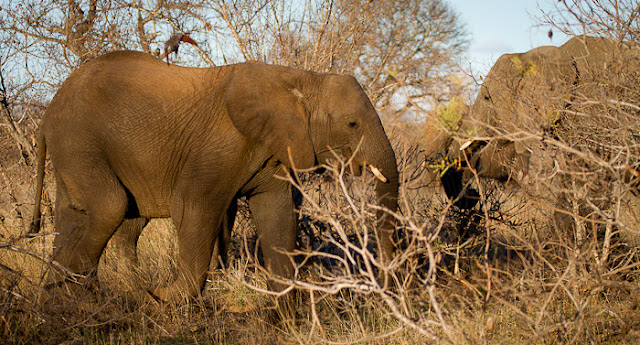Morning Drive
(Shadrack, Herold, Peter, Marka, Godfrey & Andrea)
Rhino (1 male)
Leopard (Makepisi & Shindzuti) / Jaydee - Jaydee River Road
Buffalo (9 Dagahboys) / Motswari - Xinatsi North
Elephant (Breeding Herd) / Peru - Lion Pan Link
Elephant (Breeding Herd) / Karans - Mamba Drive
Lion (4 of 'Motswari6') / Mbali - Just south of Woza Woza
Afternoon Drive
(Herold, Shadrack, MArka, Peter & Andrea)
Rhino (1 male)
Lion (4 of 'Motswari 6;) / Mbali - Just South of Woza Woza
Elephant (Breeding Herd) / Mbali - Nkau Road
Elephant (Breeding Herd) / Karans - Karans Southern Access
Leopard (Mbali) / Peru - Pan Road
Buffalo (4 Daghaboys) / Karans - Moeniejag Crossing
The morning starting with 9 cold buffalo just south of camp. They were not budging and we therefor had a rather tricky visual through mopane trees. Marka found lion tracks and began following up with quite a few others helping. I needed lion but with so many people already in the area, I decided to head south in search of rhino. It wasn't long before Marka found the 'Motswari 6' (or 5 should I say as one is missing) just south of Woza Woza cutline. It was of course a very popular sighting and knowing the lion would be there in the afternoon, I decided to leave it until then.
Our plan worked sooner than expected as Jacky spotted a large male rhino. He wasn't the most relaxed and kept walking into thicker and thicker bush. We stayed with him as long as possible but did not want to disturb too much so after a couple of pictures we moved on.
On our way to respond to a herd of elephant, we were travelling on the road parallel to the river. I saw Jacky spot something tracks wise on the road and so I instinctively looked up. Sure enough, there Makepisi male leopard was sitting up in a Weeping Boer Bean tree with a bushbuck kill. Jacky had seen the fresh drag mark across the road - certainly was the quickest finding of a leopard from a drag mark I have ever had! He climbed down the tree and into the riverbed which made me think it was Shindzuti, the nervous brother, but then he walked back up into the tree and started feeding. Only now, as I started to type up the blog have I noticed that the spot pattern on the "first" leopard up in the tree is 4:4 (Shindzuti) and the leopard who climbed back up and started feeding is 2:2 (Makepisi). So both brother were there! It makes sense as Marka was explaining that the way the carcass had been ripped made it look like two leopards had been feeding on it. Talk about bush CSI. Good to see the boys back together again!
 |
| Shindzuti climbing down the tree |
 |
| Makepisi feeding (note the 2:2 spot pattern!) |
Despite my efforts to relocate the herd of elephant, I could not find them as they had wondered deep into a drainage line, and I did not have enough time to go crashing through the bush. So, instead we headed back to camp enjoying some general game along the way.
 |
| Terrapins sunning themselves up on a log |
I headed straight to the lion sighting in the afternoon. The two females were feeding while the males rested up in the shade. Most guys had been calling the sighting in as the Mafikizolo pride, however, Jacky and I started chatting about how young the males were and then noticed how old the females were and how relaxed they seemed to be. It turns out that it was 4 our of the 'Motswari 6' that seem to wander into our area every now and then. They are such an awesome pride to watch.
 |
| Hooded Vulture awaits a meal |
 |
| Head right in the carcass |
 |
| Tree Wistaria - Bolusanthus speciosus |
After the lion, we followed up on a herd of elephant nearby which was a huge relief after not having found them in the morning. It was a huge herd and we sat with them until just before the sun went down. Closeby, Mbali female leopard was found and some of the guys had a great sighting of her.
Another great day in the Timbavati!





































Ditto Andrea, and thank you for sharing it.
ReplyDeleteYou are so right - definitely a great day and we hope the 4 days we are there will be equally spectacular
ReplyDeleteAndrea, the two storks would they be young black storks? Love the wisteria. Very intrigued by your comment about the leopard's spots, is it possible to have a close up to explain what you mean, although I have heard before that lions can also be identified by their whisker-patterns
ReplyDeleteHi Sheila - the storks are juvenile Saddle-billed Storks! The best way to understand the "spot pattern" is to look at the profiles of the leopards in our area on the side tab on this blog! Chad did individual profiles showing the spot patterns and distributions. Basically though, leopards have spots above the whisker line and these, combined with other characteristics, territories and behaviours are used to identify individual leopards.
ReplyDeleteThanks Andrea, and thrilled with the young saddle-billed storks!Roberts doesn't picture juveniles and I was expecting something more like the adults, but I see it says at least 6 months before they get the'saddle'
DeleteGreat big 5 day Andrea... Love the pictures of the leopards, well Makepisi actually!
ReplyDeleteThanks for another great update on a awesome day in the bush.
Cheers
Lourens
She hasn't featured in the blog lately, but has anyone seen Kuhanya recently, or has Chad had to find a new girlfriend?!!
ReplyDeleteWould love to know?
Greetings to all at Motswari, Sue and John